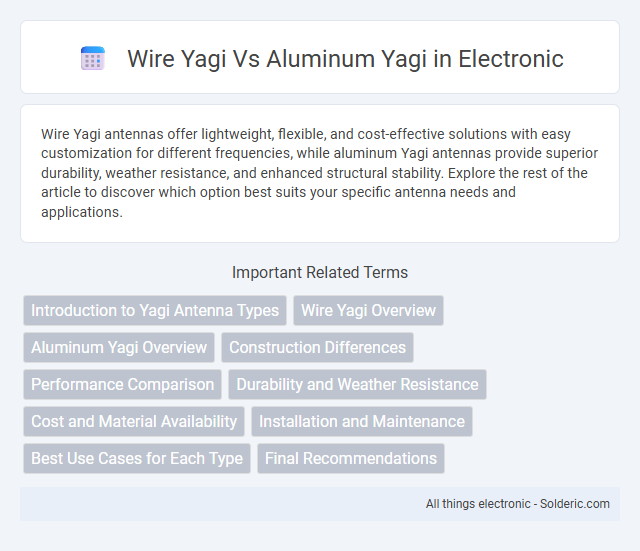Wire Yagi antennas offer lightweight, flexible, and cost-effective solutions with easy customization for different frequencies, while aluminum Yagi antennas provide superior durability, weather resistance, and enhanced structural stability. Explore the rest of the article to discover which option best suits your specific antenna needs and applications.
Comparison Table
| Feature | Wire Yagi | Aluminum Yagi |
|---|---|---|
| Material | Copper or galvanized wire | Aluminum tubing |
| Weight | Lightweight | Heavier but sturdy |
| Durability | Less durable, prone to weather damage | High durability, corrosion-resistant |
| Cost | Low cost, economical | Higher cost, investment |
| Performance | Good for indoor/use in limited space | Superior gain and directivity |
| Installation | Easy and flexible installation | Requires mounting structure |
| Maintenance | Frequent inspection needed | Low maintenance |
Introduction to Yagi Antenna Types
Wire Yagi antennas are lightweight and cost-effective, primarily used for portable or temporary setups, offering ease of construction with flexible materials. Aluminum Yagi antennas provide superior durability, weather resistance, and structural integrity, making them ideal for permanent installations and higher-performance applications. Your choice depends on whether you prioritize portability and budget or long-term reliability and strength in antenna design.
Wire Yagi Overview
A Wire Yagi antenna features lightweight, flexible elements made from copper or other conductive wire, offering ease of installation and cost-effectiveness compared to aluminum Yagi models. Its wire construction typically provides good electrical conductivity and can be more resistant to bending or damage in certain environments. Your choice between wire Yagi and aluminum Yagi should consider factors such as durability, weight, and specific application requirements.
Aluminum Yagi Overview
Aluminum Yagi antennas offer superior durability and weather resistance compared to wire Yagi models, making them ideal for long-term outdoor use. Their lightweight yet sturdy construction enhances signal stability and reduces maintenance needs. Commonly used in amateur radio and broadcasting, aluminum Yagis provide consistent performance across a wide range of frequencies.
Construction Differences
Wire Yagi antennas feature lightweight, flexible wire elements that are often easier to construct and repair, offering cost-effective solutions for amateur radio enthusiasts. Aluminum Yagi antennas use rigid aluminum rods or tubing, providing greater durability, structural strength, and resistance to environmental factors like corrosion and wind load. The choice between wire and aluminum construction impacts the antenna's weight, longevity, maintenance, and performance stability in varying weather conditions.
Performance Comparison
Wire Yagi antennas typically offer lightweight construction and cost-effectiveness but may exhibit slightly lower gain and narrower bandwidth compared to aluminum Yagi antennas. Aluminum Yagi antennas provide superior durability, higher structural stability, and generally better performance in terms of signal gain and noise reduction, ideal for outdoor and long-term installations. Performance metrics such as front-to-back ratio and SWR tend to be more consistent in aluminum Yagi antennas due to their rigid and corrosion-resistant materials.
Durability and Weather Resistance
Aluminum Yagi antennas offer superior durability and weather resistance compared to wire Yagi antennas due to their corrosion-resistant properties and robust structure. Wire Yagi antennas are more susceptible to environmental damage such as rust, stretching, and degradation from prolonged exposure to moisture and UV rays. The aluminum construction ensures long-term performance and minimal maintenance in harsh outdoor conditions.
Cost and Material Availability
Wire Yagi antennas typically offer lower cost and easier material availability since they use readily accessible materials like copper or aluminum wire, making them ideal for budget-conscious projects. Aluminum Yagi antennas involve more expensive raw materials and specialized manufacturing processes, increasing both initial investment and time for procurement. Your choice depends on balancing affordability and material accessibility against desired performance and durability.
Installation and Maintenance
Wire Yagi antennas are lightweight and flexible, making installation simpler on temporary or irregular surfaces, while aluminum Yagi antennas require sturdy mounting due to their rigid structure. Maintenance for wire Yagis often involves regular tension checks and corrosion prevention on exposed wires, whereas aluminum Yagis need inspections for physical damage and potential oxidation of metal parts. Both types benefit from periodic cleaning, but aluminum models tend to have longer lifespans with less frequent upkeep under harsh environmental conditions.
Best Use Cases for Each Type
Wire Yagi antennas excel in temporary setups and portable operations due to their lightweight design and ease of assembly, making them ideal for field communications and emergency use. Aluminum Yagi antennas offer superior durability and weather resistance, suited for permanent installations and long-term outdoor use in harsh environments. Your choice depends on whether you prioritize portability and quick deployment or structural strength and longevity.
Final Recommendations
For your antenna needs, aluminum Yagi antennas provide greater durability, lightweight construction, and resistance to corrosion, making them ideal for long-term outdoor use. Wire Yagi antennas offer cost-effective, easy-to-build solutions suitable for temporary or experimental setups but may lack structural strength and weather resistance. Choose aluminum Yagi for permanent installations requiring reliability, while wire Yagi suits budget-conscious or short-term applications.
wire yagi vs aluminum yagi Infographic

 solderic.com
solderic.com